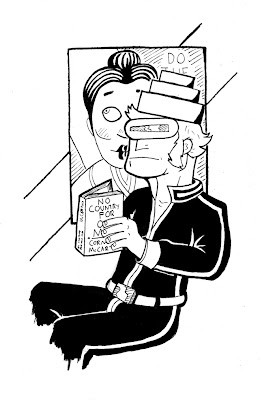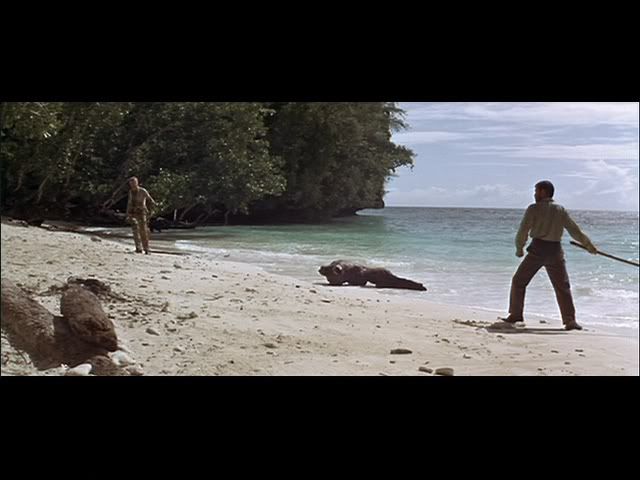 Originally written on 17 November under the
Originally written on 17 November under the nom de plume
Julio Harkonnen. Image by the wonderful Clay Cooper.May 21st
I’ve rarely ever been black bagged. Also, I’ve rarely ever been thrown into a car trunk by Russian spewing Special Forces. I must say that I really wouldn’t recommend it, either.
After several hours of bumpy roads, I was dragged out of a car and down a flight of concrete stairs. There, in a dingy basement, my eyes tried to adjust to the first light I had seen for hours. There, hunched over the carcass of what was once a white Siberian tiger was the man I was summoned to meet. He started separating the feline’s hide from its flesh as he whistled what sounded like “L’Internationale.” After a couple of seconds he stopped sawing and looked at me.
“Ah, you are journalist, yes?”
Yes?
“Come in for bro-grab.” Before I had an opportunity to meet him or dive out of the way, he was on me like an angry bear. He then released me and looked me over. “Yes, you will do.”
I wondered how hard it would be to get tiger blood out of flannel. It wouldn’t be the last unique question I’d ask on my travels.
That was how I met former Russian president Vladimir Putin.
***
What I found out in my first few hours with Vladimir was he was not much on shirts. At first I thought he was just really proud of his communism-forged abs, but after I while I discovered it was just a cover for a severe chaffing problem. He would stay half naked for most of our travels.
After a few awkward moments, he pulled from his Jordache jeans a piece of yellow, lined paper. He unfolded it on the table and cleared his throat. “I come to America.” He stopped right there and raised a single eyebrow at me. I considered agreeing with him that, yes, he did come to America, but then he went on. “For years I think to myself, ‘Vladi, these Yankees, they are not like us Russians, yes?’ [Yes] I think I want to—how you say—road trip. See what makes Yankees click. I want to see Real America.”
Through his vodka-laced voice and my heat stroke I could hear that he was serious, he wanted me to write about his—our—journey through the arteries of America. He had selected me—probably for my lack of a home security system and any close family ties—to chronicle this pilgrimage.
***
Vladimir took me by the arm outside. There in the waning daylight he showed me what he called “The Sturgeon,” a massive, red, convertible Cadillac. This was to be our ferry and Vladimir was to be the Virgil to my Dante. That is if I understood Wikipedia correctly.
May 24nd
We stopped at some nameless greasy spoon across from a Shell station. I’d been holding in a 64 oz. Mountain Dew since we started and Vladimir refused to stop because we were “good time making” (He then cackled and stomped on the accelerator). So when we finally did stop at a restaurant I had barely undone my button-fly before the call hit me. When I returned there was a slice of pie and a cup of coffee to greet me at our table. I told Vlad that I wasn’t hungry, but then he gave me that I-will-gulag-the-fuck-out-of-you look, so I took a bite out of my own sense of self-preservation.
I washed down the bite with a slug of black coffee and he started laughing.
“Ha! I poison your coffee make!” he said as he slapped his knee.
“Huh?” is all I could get out.
“Polonium!” Then he busted out even louder, making a diabetic amputee with a shirt that said ‘God Don’t Make Junk’ to turn around and stink-eye us. “Oh man, you should sees your face! I totally had gots your going!”
He’s said this at every single meal we’ve had together. I’m starting to think he’s not joking around.
May 28th
Vladimir has an entire collection of knives. I have no idea where he got these things from or why he has eighty-nine of them. The trunk is full of them. That and the mummified remains of a timber wolf.
He shrugged. “He looked at me.” He sniffed. “Once.”
May 30th
“I call it the Rasputin,” he says to me, pouring the Stoli through a funnel filled with ice into an Iron Man collector’s cup. He said this as if he was answering a question I never thought to ask. “Is three measures vodka.” He poured a little bit more. “And two measures vodka.” The bottle went dry and sailed out the window. “Is real man’s drink.”
I told him I could man the Sturgeon if he wanted to. He waved me off and said that I needed to “nut up” and that I was acting like “a Kazakh.” For some reason, I thought of Thanksgiving at my parents’ house.
June 4th
I couldn’t tell if it was the time we ran out of gas outside of Del Rio or the time he got high on mescaline and drove through a field of sheep, but something inside him changed. Right as I gave up on wondering what he was thinking, he spoke up. “I am grow blue-ball violent.” I was sure this was a collection of words that made sense to Vladimir, but to me the meaning was entirely lost. “I am in need of combat. I am need to see wolverine fight! But wheres?”
I had to admit I didn’t know where. Conflict was something I saved for hypothetical discussions I had with my boss or for the internet. So I couldn’t aid him in his quest for animal-bound violence. Not that I wanted to.
As we reached the top of a hill, he looked out to where the Earth met the sky. “We will goes to land of the Aztecs. We’s will journal to Mexico.” Sanity and reason, I would later find out, left us on that hill.
June 6th
What follows was written down after all was said and done. My notebook was lost when the Sturgeon lost a tire and burst into flames against an elm tree. When I regained consciousness, I found Vladimir standing over me smirking. It appeared, in the confusion, he had lost his shirt.
He nodded at me and winked. Without a word, miles from anywhere, we began to walk.
***
The black wilderness seemed to stretch for hundreds of miles in every direction and thousands of years into the past. It was as though we were in a land that man had never walked through before. Even Nature seemed to be absent from the earth we walked over. It was just us two and our footfalls.
Out of the moonless night Vladimir said, “I think I maybe get it. Maybe not what I cames for, but I know something.” He stopped and took up a handful of pebbles and sand. “I knows something.” He let the gravel fall from between his fingers.
Just then I saw it. Civilization. A glittering beacon out in the middle of this expanse of misery. We started running for it. Or I thought we did. Hours of Hell ended in a few seconds of sprinting (followed by ten minutes of breathless hobbling). I collapsed against the tin side of a truck stop. A bearded man that looked like Jerry Garcia spat a mouthful of tobacco a few inches from my foot. I told him that I needed to find a phone and that my friend Vladimir and I had an accident and we needed to call for help. The man just stared at me.
“Who’s Vladimir?”
I looked to my left and my right, but Vladimir was nowhere to be found. Sometime in my dash for salvation he had slipped away into the night. Maybe it had something to do with what he found out on that walk or maybe it had to do with the mushrooms he ate or maybe, just maybe Vladimir was the kind of man that needed to be lost in the shadow of the Earth.
[Editor’s Note: The writer could not be found for editorial purposes. Though, when his
apartment was checked on, it looked like he had packed and his suitcases were missing.]


















